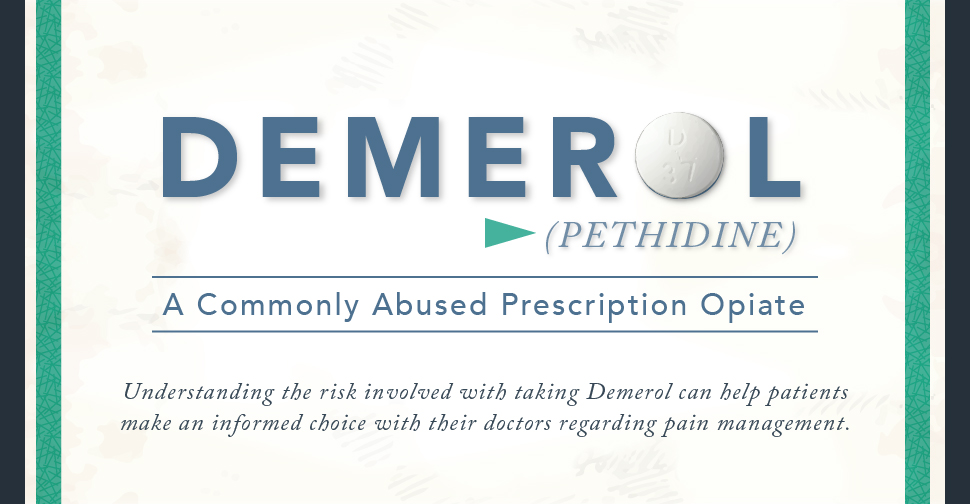
Demerol (Pethidine), the brand name for meperidine, is a prescription opiate designed to relieve moderate to severe pain. The effectiveness of Demerol makes it a useful tool for alleviating the pain experienced during labor and delivery, severe accidents, and other chronic medical conditions.
Demerol works by altering the body’s perception of pain in the central nervous system. The effects are similar to that of morphine and can cause feelings of pleasure or cause giddiness. The potency of the euphoria experienced while taking Demerol can lead patients to become dependent in a short period of time. Understanding the risk involved with taking Demerol can help patients make an informed choice about pain management.
Demerol Administration
Demerol is classified as a schedule II controlled substances and cannot be obtained legally without a prescription. Due to the high risk of addiction, physicians rarely prescribe the drug for outpatient use.
When prescribed, Demerol can be taken orally in tablet or liquid form, or through an injection administered by a physician. The average dose is taken every 3-4 hours or as needed. The effects are experienced for 4-5 hours.
People who abuse Demerol to get high often crush, chew, snort, or inject the drug to quicken and lengthen the effects. These behaviors increase the risk of overdose by increasing the onset speed of its symptoms.
Behavioral Indicators Of Demerol Addiction
When an individual becomes addicted to Demerol, they may seek prescriptions by visiting multiple doctors or the ER with faked or self-inflicted injuries. This type of uncharacteristic behavior is often a symptom of opiate addiction. Other common behavioral indicators of Demerol addiction include:
- “Losing” prescriptions to obtain more from a physician
- Disengaging from friends, family, and community to hide drug abuse
- Borrowing money, selling possessions, or stealing to afford the drug
- Lying about the amount consumed
- Driving under the influence or engaging in other risky behaviors
- Neglecting responsibilities at work or home
- Mood swings, agitation, depression, or impulsiveness
Demerol is often called “Juice,” “Dillies,” Dust,” or simply “D” on the street and can cost anywhere from $2.50-6 per dose. Behavioral changes often interfere with daily function or rationality of those struggling with addiction.
Physical Symptoms Of Demerol Abuse
As with most opioid medications, a tolerance can build over time, making the drug less effective at normal doses. Unfortunately, this means even people who aren’t abusing the drug may end up developing an addiction by treating their pain symptoms. Some physical symptoms of Demerol abuse include:
- Frequent tiredness or “nodding off”
- Gastrointestinal distress (nausea, vomiting, diarrhea, etc.)
- Heavy perspiration
- Disorientation
- Trouble breathing
- Constant itching
The Center for Disease Control (CDC) has labeled opiate addiction an epidemic, prompting stricter regulation of opioid prescriptions. Recent surveys suggest that teens who reported abusing prescription opiates claimed that the drugs were both easier accessed and considered not as dangerous as street drugs. The CDC is hoping to raise awareness and educate the public on the dangers of opioid abuse.
Demerol Overdose Statistics And Symptoms
Demerol overdose is common due to the drug’s high potency. Though many people don’t see the dangers of prescription medications, nearly 50% of opioid overdose deaths are from prescription opioids. Since 1999, the number of deaths from prescription opioid overdose has nearly quadrupled. Demerol overdose symptoms include:
- Respiratory failure
- Extreme drowsiness or lethargy
- Weak, limp muscles
- Hypothermia and cold, clammy skin
- Seizures
- Coma
Demerol becomes significantly more dangerous when combined with other substances. Central nervous system (CNS) depressants such as alcohol and barbiturates can intensify sedation and increase the risk of respiratory failure. Stimulants like cocaine and amphetamines can interact with Demerol by masking intensity, rendering the user incapable of regulating the amount of drugs being consumed. It is important to seek medical attention immediately in the event that opiate overdose is suspected.
Demerol Detox And Withdrawal
Demerol withdrawal intensity will vary, depending on the severity of the addiction, the volume of drug that was used, and how frequently it was used. Symptoms of withdrawal are typically experienced within 24 hours of the last dose, although some begin to feel symptoms in as little as three hours. Symptoms peak around 2-3 days and last about 1-2 weeks.
Common symptoms of Demerol withdrawal include:
- Anxiety, paranoia, and agitation
- Hallucinations
- Insomnia
- Nausea and vomiting
- Runny nose and eyes
- Trouble breathing
- Muscle aches
- Sweating, chills, and dry mouth
- Heightened blood pressure
A medical detox program is highly advised to help alleviate these symptoms. Doctors typically advise tapering off the drug to decrease the harsh effects of Demerol withdrawal. Additional treatment options can aid in medically-monitored rehabilitations.
Treatment Options
Demerol cravings often continue after detox, which is why follow-up care is so important. While detox eliminates the dangers of physical addiction, psychological dependence may still remain. A plan of action can help to overcome temptation and maintain sobriety while in recovery. Common treatments used to treat Demerol addiction include:
Suboxone and Subutex – Both medications contain the same active ingredient buprenorphine, which is used to aid in managing the pain and discomfort of opioid withdrawal. Suboxone contains an added opioid antagonist called Naloxone, which lessens the likelihood of relapse by blocking opioid receptors in the brain.
Supervised care with therapeutic services through a rehab facility – Many outpatient care centers require new patients to undergo detox with an inpatient rehabilitation facility prior to admission.
Inpatient and outpatient rehabilitation plans include cognitive behavioral therapy, group therapy, and motivational enhancement therapy to help those struggling with addiction embrace recovery, develop the tools to cope with everyday life, and remain sober after rehab.
Regaining Control
If the effects of Demerol addiction are interfering with your life, you may feel overwhelmed by the prospect of recovery. The good news is that you’re not alone. Many individuals have walked away from Demerol addiction with a new sense of health and well-being.
Admitting to yourself that you need a change is the first step in identifying and resolving the problem. Recovery is not an easy process, but one that is possible with persistence and the loving care of a support group. This can include friends, family members, and professional rehab experts.
We Can Help
 If you or a loved one is struggling with Demerol addiction, now is the time to regain control. The caring staff at DrugRehab.org is here to guide you through the recovery process and help you find the tools needed to find relief from addiction in a healthy and safe way. Contact us to take the first step today.
If you or a loved one is struggling with Demerol addiction, now is the time to regain control. The caring staff at DrugRehab.org is here to guide you through the recovery process and help you find the tools needed to find relief from addiction in a healthy and safe way. Contact us to take the first step today.
